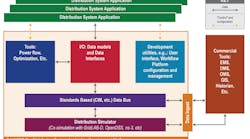Part 1 of this series discussed the key aspects of a distribution operation landscape, which will define the successful utility of the future. Part 2 examines challenges that must be addressed to achieve agile, cost-effective deployment of advanced distribution functionality.
Advanced Distribution Management Systems (ADMS) are an increasingly important tool for the management, operation and control of electric power distribution systems. The ADMS is an enhancement over the DMS (Distribution Management System) of the past by adding new and improved advanced grid management applications. The ADMS integrates the three core modules of Distribution Supervisory Control and Data Acquisition (D-SCADA), Outage Management System (OMS) and Advanced Applications through a single-common power system model (as-operated state of the power system) and user interface.
A key benefit in moving from siloed systems to integrated ADMS is reduced integration costs by eliminating system-to-system integration. The trade-off, however, has been a move to single-vendor solutions, limiting the utility to applications from the ADMS vendor or incurring additional integration costs to add in functionality from other vendors. Given the diverse range of application domains in distribution management, this trade-off constrains the ability of the utility to select the optimal application for a particular domain. However, there is a strategy that can deliver an integrated system while also preserving a “best of breed” approach to application deployment for utilities.
GridAPPS-D, a working ‘real-world’ example
GridAPPS-D, sponsored by the U.S. Department of Energy, is an open-source implementation of a system for the development of portable, advanced functionality for complex electric power distribution systems of the future. The platform provides a simulated distribution system environment allowing the use of either PNNL’s GridLAB-D and/or EPRI’s OpenDSS as they create and test their software. By using the time-series capabilities of the distribution simulators, the applications can run in real-time so that testing and evaluation can be performed with the operators who would be the eventual users.
The applications being developed in the platform use a CIM-compliant API to interact with network model components receiving data about their current state or sending commands to change their state. An example would be the opening or closing of a switch. The GridAPPS-D API also supports the ability to generally query the network model, and other available data sources, enabling an application to configure itself to different network models. The ability for applications to interact with a single common network model that is used by all functions is essential when there are multiple applications with potentially different vendors. Past utility experiences with multiple applications using different network models have shown that this approach is labor-intensive, expensive and does not scale as systems are added. A standards-based common network model will be essential as ADMS systems are used for distribution systems with increased complexity that require the incorporation of additional functionality/applications.
In parallel with the development of the platform, the GridAPPS-D project also developed several example applications such as volt-VAR optimization, renewable resource dispatch, fault location and system reconfiguration, and state estimation. These applications were implemented to demonstrate the power of the GridAPPS-D platform and the flexibility obtained through the use of standard APIs, which allow for advanced application development in a data-rich environment.
The current version of GridAPPS-D supports the development of applications that would be deployed in a distribution system control room environment. A current focus of the project is considering the requirements to support the development and deployment of applications that include agents operating in a distributed manner to provide local, intelligent control and coordination at locations from substations to the grid edge. As the complexity of distribution systems continues to grow, we expect distributed solutions will be needed to meet many of the emerging operational challenges.
As we work to decarbonize sources and uses of energy in electric power systems, the complexity of the system will continue to grow. Distribution utilities will need to move beyond current approaches for management, operations and control of their system by taking advantage of software system architectures designed to manage unprecedented complexity. The use of standards-based architectures will help the industry tame the complexity in a timely and cost-effective manner. The GridAPPS-D platform is a reference example that the electricity industry can use to move toward open architectures and APIs, as so many other industries have done.
Two key requirements come to the forefront as this approach is considered for utility, operations, production environments - platform architectures and a standards-based approach. Both of them are addressed in the next two sections.
Platform architectures are becoming common in ADMS
As the industry has gained experience with ADMS technology and systems, most vendors have moved to a platform architecture. This architectural approach helps address integration costs within the product ecosystem of the individual vendor. The modular nature helps reduce ongoing maintenance and technology upgrade costs. However, it does not, by itself, address the cost to utilities if they wish to add functionality from other vendors. This is, in part, because existing platform architectures allow only some interfaces to be exposed and be made available to others. In addition, key constructs, such as APIs and data models for the platform, are often proprietary.
The Industry has recognized that addressing the introduction of key technologies such as Distributed Energy Resources (DERs), Electric Vehicles (EVs), Microgrids, and others requires an architecture that is a combination of centralized plus distributed (hierarchical) plus decentralized. Expecting the ADMS vendor to have all the solutions for the needs of the future may be overly optimistic as vendors are concentrating on solving specific niche problems along the value chain. This is especially important as more functionality moves to the edge of the grid. This means that utilities would ideally be able to integrate solutions from different vendors that may have solved a specific problem much more elegantly than their ADMS platform vendor.
For this need to be realized, future distribution operations require a standards-based architectural approach that allows a utility, if it chooses, to easily integrate applications/ systems from different vendors to solve the operational complexities that it may be faced with.
Benefits of a standards-based approach
The best approach to providing cost-effective integration and enabling advanced control and coordination applications for decarbonized distribution systems is to move to a standards-based approach, one that uses open APIs and architectures. With this approach, the industry can separate the problem of data integration — a problem that grows in complexity with increased deployment of distribution system DERs and load electrification — from the problem of delivering the functionality required to manage, operate and control the different parts of the distribution system.
An open architecture can support offerings from multiple vendors with clearly defined market segments. Through this approach, utilities can select functionality that is better matched to their operational environment. The benefits of this approach include:
- Scalability in features (up or down) for utilities of different sizes
- Scalability to match growth in system complexity that will accompany decarbonization
- Applications portable from one system to another with reduced system integration needs
- Applications can be developed by vendors independent of the platform vendor thanks to API standardization
- Implementation architecture flexibility where applications and services can be distributed independently across utility or even in mixed hybrid cloud environments.
This is not a new or a novel approach. Other industries have already done it and with great success. Examples abound in (1) online banking (2) cloud computing (HTTPS + REST), (3) transportation (CAN bus), (4) industrial electronics (Modbus), (5) building controls (BACnet and Modbus). Added to all of this is the ubiquitous USB standard that almost every human being on the planet is aware of as they interact with their PCs, smartphones and other electronic devices.
Even the utility industry has standards. A few excellent examples are (1) CIM (Common Information Model) is heavily used by almost all utilities when exchanging transmission system models; (2) ICCP (Inter Control-Center Communications Protocol), which is used to exchange real-time data between control centers; (3) DNP3, a set of communications protocols used in real-time operations and control; (4) IEC 61850, the international standard defining communication protocols for intelligent electronic devices at electrical substations; and (5) IEEE 2030.5, an application layer protocol that supports integration with DERs, pricing, metering, etc.


